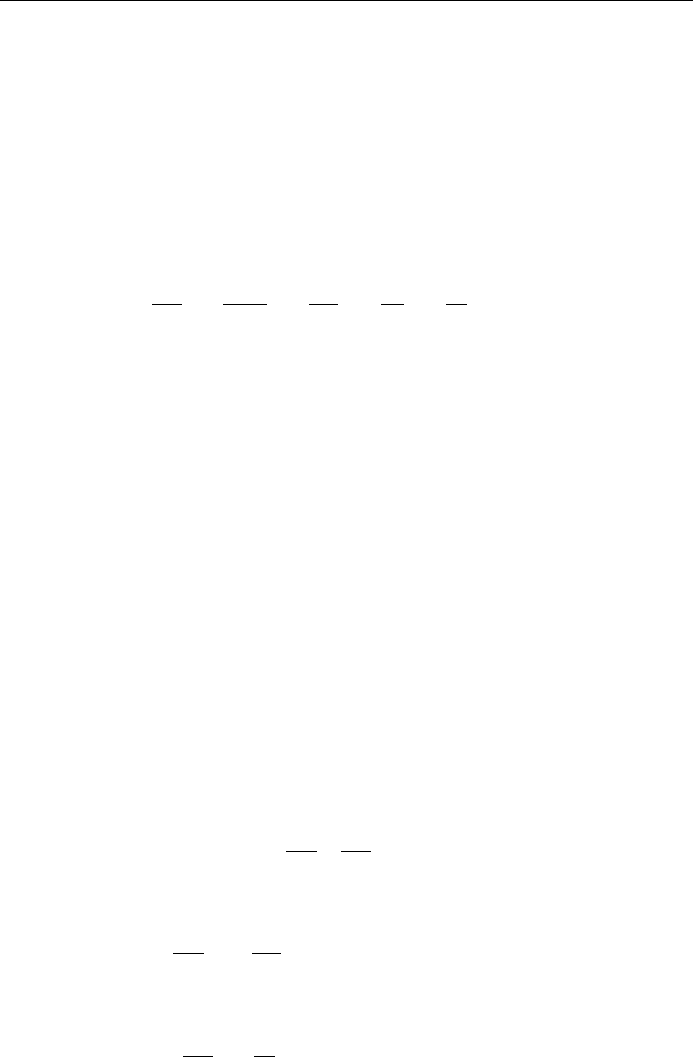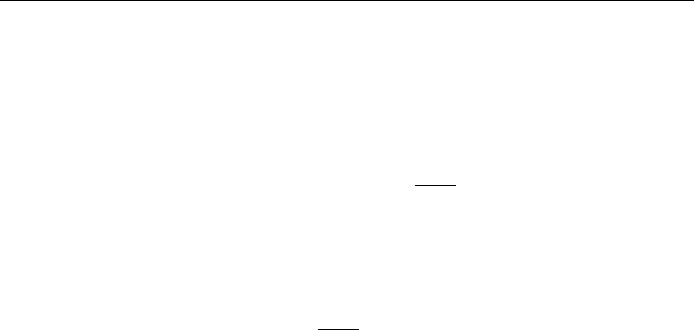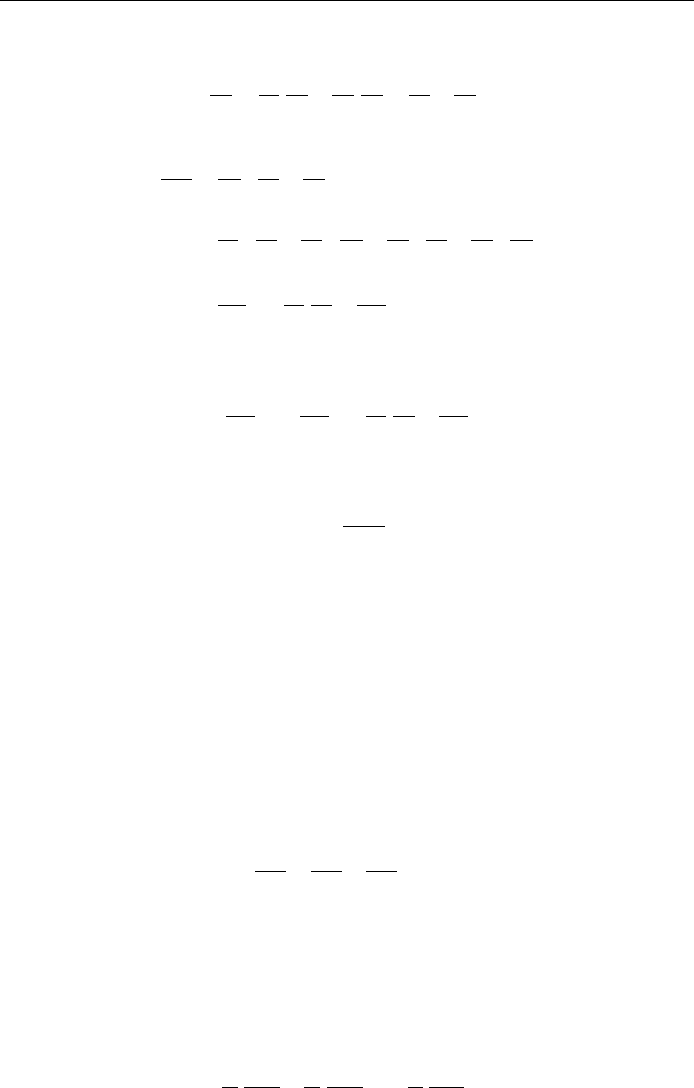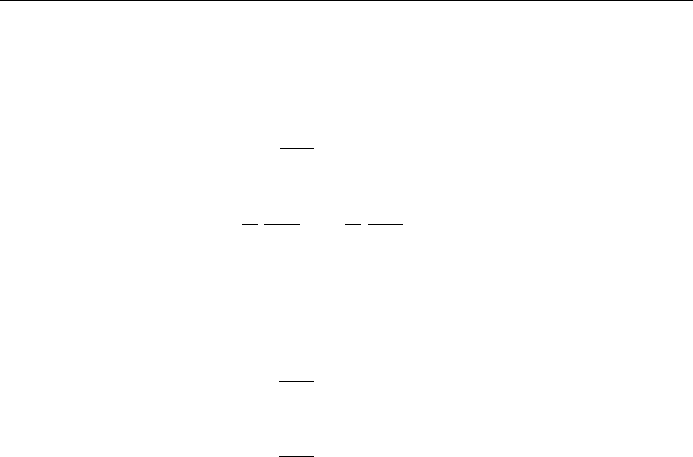Chow T.L. Mathematical Methods for Physicists: A Concise Introduction
Подождите немного. Документ загружается.


9.6 Find
L
ÿ1
15
p
2
4p 13
:
9.7 Prove that if f
0
x is continuous an d f
00
x is piecewise continuous in every
®nite interval 0 x k and if f x and f
0
x are of exponential order for
x > k, then
Lf Fx p
2
Lf x ÿ pf 0ÿf
0
0:
(Hint: Use (9.19) with f
0
x in place of f x and f
00
x in place of f
0
x.)
9.8 Solve the initial prob lem y
00
tÿ
2
ytA sin !t; y01; y
0
00.
9.9 Solve the initial prob lem yFtÿy
0
tsin t subject to
y02; y00; y
00
01:
9.10 Solve the linear simultaneous diÿerential equation with constant coecients
y
00
2y ÿ x 0;
x
00
2x ÿ y 0;
subject to x02; y 0 0, and x
0
0y
0
00, where x and y are the
dependent variables and t is the independent variable.
9.11 Find
L
Z
1
0
cos au du
:
9.12. Prove that if Lf x Fp then
Lf ax
1
a
F
p
a
:
Similarly if L
ÿ1
Fp f x then
L
ÿ1
F
p
a
hi
af ax:
386
THE LAPLACE TRANSFORMATION

10
Partial diÿerential equations
We have met some partial diÿerential equations in previous chapters. In this
chapter we will study some elementary methods of solving partial diÿerential
equations which occur frequently in physics an d in engineering. In general, the
solution of partial diÿerential equations presents a much more dicult problem
than the solution of ordinary diÿerential equations. A complete discussion of the
general theory of partial diÿerential equations is well beyond the scope of this
book. We therefore limit ourselves to a few solvable partial diÿerential equations
that are of physical interest.
Any equation that contains an unknown function of two or more variables and
its partial derivatives with respect to these variables is called a partial diÿerential
equation, the order of the equation being equal to the order of the highest partial
derivatives present. For example, the equations
3y
2
@u
@x
@u
@y
2u;
@
2
u
@x@y
2x ÿ y
are typical partial diÿerential equations of the ®rst and second orders, respec-
tively, x and y being independent variables and ux; y the function to be found.
These two equations are linear, because both u and its derivatives occur only to
the ®rst order and products of u and its derivatives are absent. We shall not
consider non-linear partial diÿerential equations.
We have seen that the general solution of an ordinary diÿerential equation
contains arbitrary constants equal in number to the order of the equation. But
the general solution of a partial diÿerential equation contains arbitrary functions
(equal in number to the order of the equation). After the particular choice of the
arbitrary functions is made, the general solution becomes a particular solution.
The problem of ®nding the solut ion of a given diÿerential equation subject to
given initial conditions is called a boundary-value problem or an initial-value
387

problem. We have seen already that such problems often lead to eigenva lue
problems.
Linear second-order partial diÿerential equations
Many physical processes can be described to some degree of accuracy by linear
second-order partial diÿerential equations. For simplicity, we shall restrict our
discussion to the second-order linear partial diÿerential equation in two indepen-
dent variables, which has the general form
A
@
2
u
@x
2
B
@
2
u
@x@y
C
@
2
u
@y
2
D
@u
@x
E
@u
@y
Fu G; 10:1
where A; B; C; ...; G may be dependent on variables x and y.
If G is a zero function, then Eq. (10.1) is called homo geneous; otherwise it is
said to be non-homogeneous. If u
1
; u
2
; ...; u
n
are solutions of a linear homoge-
neous partial diÿerential equation, then c
1
u
1
c
2
u
2
c
n
u
n
is a lso a solution,
where c
1
; c
2
; ...are constants. This is known as the superposition principle; it does
not apply to non-linear equations. The general solution of a linear non-homo-
geneous partial diÿerential equ ation is obtained by adding a particular solution
of the non-homogen eous equation to the general solution of the homogeneou s
equation.
The homogeneous form of Eq. (10.1) resembles the equation of a general conic:
ax
2
bxy cy
2
dx ey f 0:
We thus say that Eq. (10.1) is of
elliptic
hyperbolic
parabolic
9
>
=
>
;
type when
B
2
ÿ 4AC < 0
B
2
ÿ 4AC > 0
B
2
ÿ 4AC 0
8
>
<
>
:
:
For example, according to this classi®cation the two-dimensional Laplace equation
@
2
u
@x
2
@
2
u
@y
2
0
is of elliptic type (A C 1 ; B D E F G 0, and the equation
@
2
u
@x
2
ÿ
2
@
2
u
@y
2
0 is a real constant
is of hyperbolic type. Similarly, the equation
@
2
u
@x
2
ÿ
@u
@y
0 is a real constant
is of parabolic type.
388
PARTIAL DIFFERENTIAL EQUATIONS

We now list some important linear second-order partial diÿerential equations
that are of physical interest and we have seen already:
(1) Laplace's equation:
r
2
u 0 ; 10:2
where r
2
is the Laplacian operator. The function u may be the electrostatic
potential in a charge-free region. It may be the gravitational potential in a region
containing no matter or the velocity potential for an incompressible ¯uid with no
sources or sinks.
(2) Poisson's equation:
r
2
u x; y; z; 10:3
where the function x; y; z is called the source den sity. For example, if u repre-
sents the electrostatic potential in a region containing charges, then is propor-
tional to the electrical charge density. Similarly, for the gravitational potential
case, is proportional to the mass density in the region.
(3) Wave equation:
r
2
u
1
v
2
@
2
u
@t
2
; 10:4
transverse vibrations of a string, longitudinal vibrations of a beam, or propaga-
tion of an electromagnetic wave all obey this same type of equation. For a vibrat-
ing string, u represents the displacement from equilibrium of the string; for a
vibrating beam, u is the longitudinal displacement from the equilibrium.
Similarly, for an electromagnetic wave, u may be a component of electric ®eld
E or magnetic ®eld H.
(4) Heat conduction equation:
@u
@t
r
2
u; 10 :5
where u is the temperature in a solid at time t. The constant is call ed the
diÿusivity and is related to the thermal conductivity, the speci®c heat capacity,
and the mass density of the object. Eq. (10.5) can also be used as a diÿusion
equation: u is then the concentration of a diÿusing substance.
It is obvious that Eqs. (10.2)±(10.5) all are homogeneous linear equations with
constant coecients.
Example 10.1
Laplace's equation: arises in almost all branches of analysis. A simple example
can be found from the motion of an incompressible ¯uid. Its velocity vx; y; z; t
and the ¯uid density x; y; z; t must satisfy the equation of continuity:
@
@t
rv0:
389
LINEAR SECOND-ORDER PDEs

If is constant we then have
rv 0 :
If, furthermore, the motion is irrotational, the velocity vector can be expressed as
the gradient of a scalar function V:
v ÿrV;
and the equation of continuity becomes Laplace' s equation:
rv r ÿrV0; or r
2
V 0:
The scalar function V is called the velocity potential.
Example 10.2
Poisson's equation: The electrostatic ®eld provides a good example of Poisson's
equation. The electric force between any two charges q and q
0
in a homogeneous
isotropic medium is given by Coulomb's law
F C
qq
0
r
2
^
r;
where r is the distance between the charges, and
^
r is a unit vector in the direction
of the force. The constant C determines the system of units, which is not of
interest to us; thus we leave C as it is.
An electric ®eld E is said to exist in a region if a stationary charge q
0
in that
region experiences a force F:
E lim
q
0
!0
F=q
0
:
The lim
q
0
!0
guarantees that the test charge q
0
will not alter the charge distribution
that existed prior to the introduction of the test charge q
0
. From this de®nition
and Coulomb's law we ®nd that the electric ®eld at a point r distant from a point
charge is given by
E C
q
r
2
^
r:
Taking the curl on both sides we get
rE 0;
which shows that the electrostatic ®eld is a conservative ®eld. Hence a potential
function exists such that
E ÿr:
Taking the divergence of both sides
rr ÿr E
390
PARTIAL DIFFERENTIAL EQUATIONS

or
r
2
ÿrE:
rE is given by Gauss' law. To see this, consider a volume containing a total
charge q. Let ds be an element of the surface S which bounds the volume . Then
ZZ
S
E ds Cq
ZZ
S
^
r ds
r
2
:
The quantity
^
r ds is the projection of the element area ds on a plane perpendi-
cular to r. This projected area divided by r
2
is the solid angle subtended by ds,
which is written dÿ. Thus, we have
ZZ
S
E ds Cq
ZZ
S
^
r ds
r
2
Cq
ZZ
S
dÿ 4Cq:
If we write q as
q
ZZZ
dV;
where is the charge density, then
ZZ
S
E ds 4C
ZZZ
dV:
But (by the divergence theorem)
ZZ
S
E ds
ZZZ
rEdV:
Substituting this into the previous equation, we obtain
ZZZ
rEdV 4C
ZZZ
dV
or
ZZZ
rE ÿ 4CdV 0:
This equation must be valid for all volumes, that is, for any choice of the volume
. Thus, we have Gauss' law in diÿerential form:
rE 4C:
Substituting this into the equation r
2
ÿrE, we get
r
2
ÿ4C;
which is Poisson's equation. In the Gaussian system of units, C 1; in the SI
system of units, C 1=4"
0
, where the constant "
0
is known as the permittivity of
free space. If we use SI units, then
r
2
ÿ="
0
:
391
LINEAR SECOND-ORDER PDEs

In the particular case of zero charge density it reduces to Laplace's equation,
r
2
0:
In the following sections, we shall consider a number of problems to illustrate
some useful methods of solving linear partial diÿerential equations. There are
many methods by which homogeneous linear equations with constant coecients
can be solved. The following are commonly used in the applications.
(1) Genera l solutions: In this method we ®rst ®nd the general solution and then
that particular solution which satis®es the boundary conditions. It is always
satisfying from the point of view of a mathematician to be able to ®nd general
solutions of partial diÿerential equations; however, general solutions are dicult
to ®nd and such solutions are sometimes of little value when given boundary
conditions are to be imposed on the solution. To overcome this diculty it is
best to ®nd a less general type of solut ion which is satis®ed by the type of
boundary conditions to be imposed. This is the method of separation of variables.
(2) Separation of variables: The method of separation of variables makes use of
the principle of superposition in building up a linear combination of individual
solutions to form a solution satisfying the boundary conditions. The basic
approach of this method in attempting to solve a diÿerential equation (in, say,
two dependent variab les x and y) is to write the dependent variable ux; y as a
product of functions of the separate variables ux; yXxYy. In many cases
the partial diÿerential equation reduces to ordinary diÿerential equations for X
and Y.
(3) Laplace transform method: We ®rst obtain the Laplace transform of the
partial diÿerential equation and the associated boundary conditions with respect
to one of the independent variables, and then solve the resulting equation for the
Laplace transform of the required solution which can be found by taking the
inverse Laplace transform.
Solutions of Laplace's equation: separation of variables
(1) Laplace's equation in two dimensions x; y: If the potential is a function of
only two rectangular coordinates, Laplace's equation reads
@
2
@x
2
@
2
@y
2
0:
It is possible to obtain the general solution to this equation by means of a trans-
formation to a new set of independent variables:
x iy; x ÿ iy;
392
PARTIAL DIFFERENTIAL EQUATIONS

where I is the unit imaginary number. In terms of these we have
@
@x
@
@
@
@x
@
@
@
@x
@
@
@
@
;
@
2
@x
2
@
@x
@
@
@
@
@
@
@
@
@
@
@
@x
@
@
@
@
@
@
@
@x
@
2
@
2
2
@
@
@
@
@
2
@
2
:
Similarly, we have
@
2
@y
2
ÿ
@
2
@
2
2
@
@
@
@
ÿ
@
2
@
2
and Laplace's equation now reads
r
2
4
@
2
@@
0:
Clearly, a very general solution to this equation is
f
1
f
2
f
1
x iyf
2
x ÿ iy;
where f
1
and f
2
are arbitrary functions which are twice diÿerentiable. However, it
is a somewhat dicult matter to choose the functions f
1
and f
2
such that the
equation is, for example, satis®ed inside a square region de®ned by the lines
x 0; x a; y 0; y b and such that takes prescribed values on the boundary
of this region. For many problems the method of separation of variables is more
satisfactory. Let us apply this method to Laplace's eq uation in three dimensions.
(2) Laplace's equation in three dimensions (x; y; z): Now we have
@
2
@x
2
@
2
@y
2
@
2
@z
2
0: 10:6
We make the assumption, justi®able by its success, that x; y; z may be written
as the product
x; y; zXxYy Zz:
Substitution of this into Eq. (10.6) yields, after division by ;
1
X
d
2
X
dx
2
1
Y
d
2
Y
dy
2
ÿ
1
Z
d
2
Z
dz
2
: 10:7
393
SOLUTIONS OF LAPLACE'S EQUATION

The left hand side of Eq. (10.7) is a function of x and y, while the right hand side is
a function of z alone. If Eq. (10.7) is to have a solution at all, each side of the
equation must be equal to the same constant, say k
2
3
. Then Eq. (10.7) leads to
d
2
Z
dz
2
k
2
3
Z 0; 10:8
1
X
d
2
X
dx
2
ÿ
1
Y
d
2
Y
dy
2
k
2
3
: 10:9
The left hand side of Eq. (10.9) is a function of x only, while the right hand side is
a function of y only. Thus, each side of the equation must be equal to a constant,
say k
2
1
. Therefor e
d
2
X
dx
2
k
2
1
X 0; 10:10
d
2
Y
dy
2
k
2
2
Y 0; 10:11
where
k
2
2
k
2
1
ÿ k
2
3
:
The solution of Eq. (10.10) is of the form
Xxak
1
e
k
1
x
; k
1
6 0; ÿ1< k
1
< 1
or
Xxak
1
e
k
1
x
a
0
k
1
e
ÿk
1
x
; k
1
6 0; 0 < k
1
< 1: 10:12
Similarly, the solutions of Eqs. (10.11) and (10.8) are of the forms
Yybk
2
e
k
2
y
b
0
k
2
e
ÿk
2
y
; k
2
6 0; 0 < k
2
< 1; 10:13
Zzck
3
e
k
3
z
c
0
k
3
e
ÿk
3
z
; k
3
6 0; 0 < k
3
< 1: 10:14
Hence
ak
1
e
k
1
x
a
0
k
1
e
ÿk
1
x
bk
2
e
k
2
y
b
0
k
2
e
ÿk
2
y
ck
3
e
k
3
z
c
0
k
3
e
ÿk
3
z
;
and the general solution of Eq. (10.6) is obtained by integrating the above equa-
tion over all the permissible values of the k
i
i 1; 2 ; 3.
In the special case when k
i
0 i 1; 2; 3, Eqs. (10.8), (10.10), and (10.11)
have solutions of the form
X
i
x
i
a
i
x
i
b
i
;
where x
1
x, and X
1
X etc.
394
PARTIAL DIFFERENTIAL EQUATIONS

Let us now apply the above result to a simple problem in electrostatics: that of
®nding the potential at a point P a dist ance h from a uniformly charged in®nite
plane in a dielectric of permittivity ". Let be the charge per unit area of the
plane, and take the origin of the coordinates in the plane and the x-axis perpen-
dicular to the plane. It is evident that is a function of x only. There are two types
of solutions, namely:
xak
1
e
k
1
x
a
0
k
1
e
ÿk
1
x
;
xa
1
x b
1
;
the boundary conditions will eliminate the unwanted one. The ®rst boundary
condition is that the plane is an equipotential, that is, 0constant, and the
second condition is that E ÿ@=@x =2". Clearly, onl y the second type of
solution satis®es both the boundary conditions. Hence b
1
0; a
1
ÿ=2",
and the solution is
xÿ
2"
x 0:
(3) Laplace's equation in cylindrical coordinates ; '; z: The cylindrical co-
ordinates are shown in Fig. 10.1, where
x cos '
y sin '
z z
9
>
=
>
;
or
2
x
2
y
2
' tan
ÿ1
y=x
z z:
8
>
<
>
:
Laplace's equation now reads
r
2
; '; z
1
@
@
@
@
1
2
@
2
@'
2
@
2
@
2
z
2
0: 10:15
395
SOLUTIONS OF LAPLACE'S EQUATION
Figure 10.1. Cylindrical coordinates.
